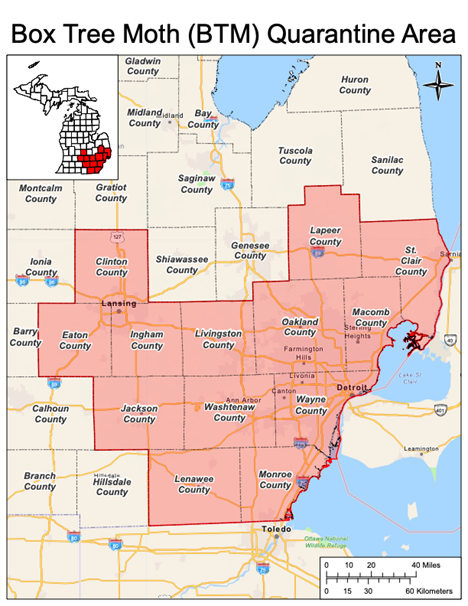Updated box tree moth quarantine and compliance agreement for shipping out of the quarantine counties
The updated compliance agreement allows businesses seven days longer to apply insecticide treatments to comply with Michigan’s box tree moth interior quarantine.

Since May 2024, a compliance agreement developed by a taskforce comprised of members of the National Plant Board and the United State Department of Agriculture (USDA) has been approved to allow the shipment of Buxus outside of the quarantined counties of Michigan’s box tree moth interior quarantine (Photo 2). The Federal Order that allows the use of this compliance agreement also removed the requirement to tag all Buxus with a regulated article label for any Buxus sold within or out of the quarantine area. To ship outside of the quarantine area, firms must meet the stipulations of a compliance agreement that include a pest management plan, trapping, insecticide treatments, inspection and certification, and prenotification for shipping out of state.
Other quarantined areas of the U.S. include all of Massachusetts and Delaware, and parts of New York, Pennsylvania and Ohio in order to control the spread of box tree moth (Cydalima perspectalis, Photo 1).

What does it mean?
As of 2025, the quarantine zone now consists of 13 southeastern and central Michigan counties as Lapeer County was added in 2025 (Photo 2). Nurseries producing boxwoods who are in the quarantine zone must adhere to stipulations that include posting a maps of the quarantine area in their retail area and ensuring that all boxwood plants are free from box tree moth. To meet these requirements, firms must train personnel to scout and ensure that boxwood does not leave the quarantine area unless the firm enters into a compliance agreement with the Michigan Department of Agriculture and Rural Development (MDARD) in order to sell plants out of the quarantine zone.
What does the compliance agreement for those shipping out of the quarantine area entail?
Since 2024, nurseries shipping out of the quarantine zone need to have a signed compliance agreement. They can do so by contacting MDARD-NurseryCE@michigan.gov or contacting their district MDARD nursery inspector. Nurseries must do the following:
- Trapping: Nurseries must install traps according to the specifications (number of traps per acre of production, change pheromone lure every four weeks, etc.) within the agreement.
- Training: Designated personnel at the nurseries must complete state-required training on box tree moth and must understand all of the facets of the compliance agreement.
- Scouting: Trained, designated personnel at nurseries must scout according to the specifications with the agreement for all signs and symptoms of the boxwood and report any positive finds of box tree moth to MDARD within two business days.
- Insecticide treatments: Nurseries must apply approved insecticide treatments to plants in the production area based on scouting and trap monitoring to target susceptible early instars within each generation and again within 14 days prior to shipping.
- Pre-shipment inspection: Designated and trained personnel at nurseries must inspect outgoing plants within 24 hours of shipment.
- Certification: MDARD inspectors will issue a certificate to the grower, which must accompany the plants to their destination.
- Notification of destination state: Nurseries need to alert the destination state’s Department of Agriculture within an agreed upon timeframe and notification protocol of the incoming shipment of boxwoods that originate in the quarantined areas and are under a compliance agreement.
- Recordkeeping: Nurseries must keep records outlined in the compliance agreement for at least 36 months.
What changes to the compliance agreement to ship outside of the quarantine area have been made for 2025?
For those firms shipping Buxus from inside the quarantine area to outside the quarantine area, there has been two adjustments to the rules based on USDA research and requirements:
- The pre-shipment insecticide must be applied within 14 days of shipment. This rule is an increase of seven days from the 2024 season.
- Mainspring (cyantraniliprole EPA #100-1543) and Perm-Up 3.2 (permethrin EPA #70506-9) were added to the acceptable pre-shipment treatment list.
For more information, check out:
- Box Tree Moth, Michigan Invasive Species webpage on Michigan.gov
- The Federal Order from USDA and Plant Protection and Quarantine from May 22, 2024
- MDARD’s Box Tree Moth Interior Quarantine
- Michigan State University Extension Box Tree Moth website
This work is supported by the Crop Protection and Pest Management Program [grant no 2024-70006-43569] from the USDA National Institute of Food and Agriculture. Any opinions, findings, conclusions, or recommendations expressed in this publication are those of the author(s) and do not necessarily reflect the view of the U.S. Department of Agriculture.



 Print
Print Email
Email




